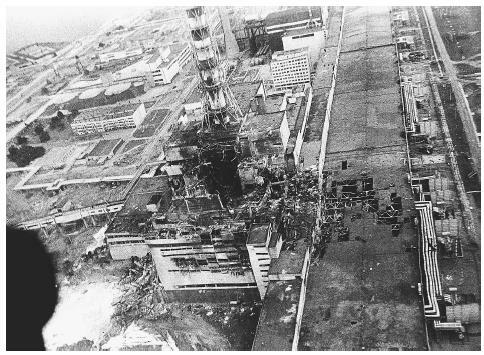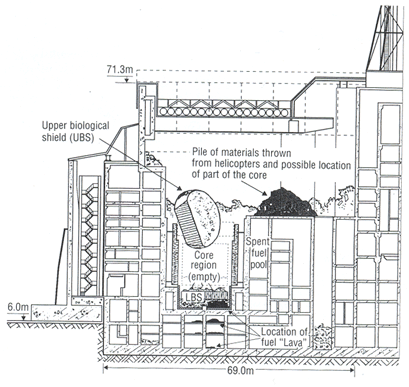Chernobyl Nuclear Power Plant is the site of a nuclear electricity generating station which is among the four identical units of the Soviet-designed RBMK1000 type. All four units are designed to produce 1,000 megawatts of electricity. One of the nuclear reactors located in the town of Chernobyl in Ukraine exploded on April 26, 1986, resulting in collapsing the building in which it was located. There was also a huge amount of radioactive plume released that deposited material carried by wind over Ukraine, Belarus, Russia, and to some extent over Scandinavia and Europe (World Nuclear Association n.pag).
The Accident
On April 25, 1986, operators in the Chernobyl Nuclear Power Plant began an experiment at Unit No. 4. This was mainly to take advantage of a scheduled annual maintenance shutdown and the purpose was to find out if the stations turbine generator could deliver temporary power to certain cooling pumps after cutting off of its steam supply. Initially, “the units operators disconnected the reactors from the emergency core cooling system which was an important safety system.
The emergency core cooling system is expected to keep the core cool when the usual systems have failed. The operators committed a series of further errors that allowed the reactors power output to fall far below planned levels and later in an attempt to restore the reactors power output, the operators caused it to go out of control. In just about 5 seconds, the cores heat output increased exponentially to the point where a steam explosion occurred that resulted in a 1,000-ton concrete lid off the reactor and damaged the roof of the reactor hall. In just another few seconds the subsequent explosion occurred when hydrogen released by the breakdown of water exploded” (Gilman n.pag) (see photo 1&2).
This resulted in burning chunks of graphite to fly through the air and initiated the fire. As a result of this accident, a plume of radioactive smoke was carried by the wind first north, toward Scandinavia, and later west and south over much of Europe (Gilman n.pag).
Impact on Human Health
The accident left several people injured and the impact of radiation continues to be a major problem. As ionizing radiation passes through the body, it interacts with the tissues transferring energy to cells and damages the DNA which is the genetic material.
Most of the early death cases in the Chernobyl accident were due to the life-threatening deterministic effects in the short term exposure to high doses. In fact, those people who were brought in for fire fighting and immediate cleanup operations were affected the most. Two deaths occurred on the spot. One person was killed by the explosion and another suffered coronary thrombosis. A third person died from thermal burns. Later, 28 died in the hospitals, bringing the total to 31 deaths in the first weeks after the accident (UN 88) (Nuclear Energy Agency 77-105).
Radiation can also have long-term health effects. However, there are no clear researches to establish this aspect as several other factors such as poverty, poor living conditions, inadequate medical services, malnutrition, and psychological impacts influence health conditions in the affected territories. Researchers have found that there is an increasing number of cases of leukemia among liquidators, a number of solid tumors, and an increase in circulatory disorders.
Similarly, researchers have also predicted that there is a possibility of thyroid dysfunctions that can have a serious impact on the health of the population, contribute to reproductive dysfunctions, particularly in women who were young girls and adolescents at the time of the accident. They have also predicted the possibility of children with birth defects and genetic illnesses for those parents who were exposed to radiation (Vainrub). Indirect exposure to radiation through food and water is also a major concern.
Impact on the Environment
After the Chernobyl Nuclear Power Plant accident, several researchers have worked and continue to work in the contaminated ecosystems. The severity of radionuclide contamination of the exposed territories varied significantly depending on the weather conditions and wind.
For instance, “in Belarus, Russia, and Ukraine, an area is considered contaminated if the indicator exceeds 1 cu/km2. Consequently 16,791 miles2 in Belarus, 35,898 miles2 in Russia, and 14,513.6 miles2 in Ukraine are considered contaminated”. The government has prohibited farming and forestry in the contaminated territories. Researchers have also found that Cs-137 and Sr-90 have the potential to contaminate the underground water table and can be a long-term threat to human health.
The accident had its impact on the plants and animals too just as in the case of human beings with a very high level of absorption of radionuclides. Precisely, the vegetation suffered and there was a significant increase in the loss of coniferous trees. There were also high levels of death reported from the surrounding territories among mammals and other animals (Vainrub).
Finally, it can be said that the Chernobyl accident in 1986 was the result of a defective reactor design that was operated with improperly trained personnel and without proper regard for safety. It is essential to follow proper safety measures in these high-risk areas and any minor problem may cause a serious impact on everyone that surrounds. In fact, after the incident, several international programs were initiated.
For instance, the International Atomic Energy Agency (IAEA) safety review projects for each particular type of Soviet reactor are noteworthy, bringing together operators and Western engineers who are mainly focused on improving safety. Additionally, it is also supported by funds. Today, there is greater awareness regarding the safety of the people working in nuclear plants.
Work cited
Gilman L. Chernobyl Nuclear Power Plant Accident, Detection and Monitoring, (2004) Encyclopedia of Espionage, Intelligence, and Security. Web.
Nuclear Energy Agency Chernobyl: Assessment of Radiological and Health Impacts, 2002 Update of Chernobyl: Ten Years On. pp 77-105.
UN 88, United Nations Scientific Committee on the Effects of Atomic Radiation (UNSCEAR), Report to the United Nations, (1988).
Vainrub, E. Twenty Years After The Chernobyl Nuclear Power Plant Accident, [2007]. Web.
World Nuclear Association Chernobyl Accident, (2007). Web.


